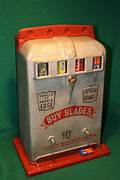The 1930s in the United States marked a period of economic turbulence, with the Great Depression casting a long shadow over the nation. In the midst of this challenging era, vending machines emerged as a curious and innovative element of American culture, offering a glimpse into the changing landscape of convenience and consumption. During the early 1930s, vending machines began to proliferate across the country, providing a novel way for people to access a variety of goods. These machines, often operated with coins, became a symbol of efficiency and modernity in an otherwise economically strained environment. The concept of vending machines was not entirely new, but the 1930s witnessed a significant expansion and diversification of their use. The products available through vending machines in the 1930s ranged from snacks and beverages to everyday necessities. Candy and gum machines, in particular, gained popularity, providing a sweet escape for individuals grappling with the harsh economic realities of the time. The simplicity and accessibility of these machines offered a small but tangible source of pleasure for many. The economic conditions of the Great Depression also played a role in the success of vending machines. As unemployment rates soared and disposable income dwindled, vending machines provided an affordable way for people to satisfy their cravings and obtain basic items without the need for human interaction. The self-service nature of vending machines resonated with a society that was becoming increasingly accustomed to streamlined, automated processes. One notable development during this period was the introduction of the first fully automatic vending machine. In 1936, the Whiz Bang, a machine that could make and dispense hot, fresh coffee, captured the public's imagination. This innovation signaled a shift in the capabilities of vending machines, moving beyond traditional snacks and beverages to more complex and immediate offerings. The rise of vending machines in the 1930s also reflected changing social norms and the evolving role of women in American society. As more women entered the workforce, vending machines provided a convenient solution for obtaining meals and snacks on the go. The machines catered to the demands of a fast-paced lifestyle, offering a degree of independence and autonomy to those navigating the challenges of the era. Despite their popularity, vending machines in the 1930s were not without controversy. Some critics raised concerns about the quality and nutritional value of the products offered, particularly as the machines expanded their repertoire to include more than just snacks. Additionally, there were debates about the impact of vending machines on traditional brick-and-mortar businesses, as well as concerns about their potential to displace workers.
1930 USA – – Vending Machines
